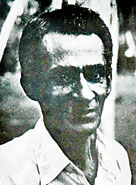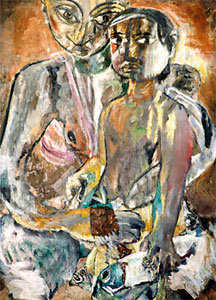DARANIYAGALA : OIL PAINTINGS, the long awaited monograph on the life and work of Justin Pieris Daraniyagala, the greatest Sri Lankan painter of the twentieth century to be launched this month fills a conspicuous vacuum that has existed on the meagre literature on contemporary art of this country. Daraniyagala was awarded, a UNESCO prize for his oil painting ‘The Fish’ (1949) at the 28th Venice Biennale, in 1956, which remains the highest international award won by a Sri Lankan painter. The painting was reproduced by New York Graphic Society as a colour print (65 x 47 cm) for worldwide distribution.
 |
| Justin Daraniyagala |
As far back as 1935, Justin Daraniyagala gained considerable stature when he exhibited his work at The Leicester Galleries, London, one of the most prestigious galleries, alongside the works of the world’s most famous artists including the greatest of the Moderns, and the innovator of Cubism, Pablo Picasso (1881-1973) in the Summer Exhibition in 1935.
This is an achievement that is unmatched in the entire Asian continent. The prominent art critic of the New Statesman and Nation, John Berger, reviewing a one-man show at the Beaux Art Gallery, London in 1954, wrote ‘In front of so many contemporary European Paintings there is nothing else to talk about except their colour and their design and their clever anticipations of somebody else’s style. If, as I said, one notices what Daraniyagala’s paintings are of, before one notices how they have been painted- that already makes them outstanding in Europe.’
Reflecting on the Retrospective Exhibition at the Smithsonian Institution, Washington, in 1969, Donald McClelland wrote: ‘One of the most significant movements in Eastern art today can be found on the Island of Ceylon. Its importance lies in the synthesis of traditional art forms and those deriving from the West which has produced painting truly Eastern in inspiration, yet of universal validity. Justin Pieris Daraniyagala helped to establish this new movement and, in fact was its most important member’.
I am delighted to handle and peruse this beautifully produced book in which every full page plate has been reproduced in full colour with incredible fidelity to the originals, giving one an appreciation of the extraordinary imagination and the innovations of Daraniyagala brought to vitalize modern painting. The non inclusion of the title on the front cover is a novel and bright concept in local publishing. The dynamics of the painting would have been obscured by a title on the front cover. The painting, by itself, is the signature of the artist! However I have my reservations about the selection and use of type faces in certain areas of the book. For example the lettering of the spine of the book could have been more effective.
The rich and varied text of the book both in terms of its writing and content deserves mention as the most thorough study of the artist to date, with each essay taking a particular theme. Exhaustively researched, clearly written and well illustrated the biographical essay Justin Daraniyagala: the artist and the man 1903-1967 by Shernavaz Colah, reveals how his art and life were inextricably linked together.
Justin Pieris Daraniyagala was born in Colombo, on July 20, 1903. He had his first introduction to art at the school of Gate-Mudaliyar A.C.G.S. Amarasekara. In 1922 he entered Trinity College, Cambridge, where he obtained a B.A. in Law. Encouraged by Augustus John (1878-1961), Daraniyagala attended the Slade School of Art from 1926 to 1927 where he studied under eminent British painters, Henry Tonks (1862-1937) and Philip Wilson Steer (1860-1942). He went briefly to Academic Julien, Paris in 1928, and returned to Sri Lanka in 1929. Daraniyagala died at his home, Nugedola, Pasyala on May 24, 1967.
Painter and veteran writer on art Neville Weeraratne, in his contribution to the publication, ‘Justin Daraniyagala and the 43 Group’ reminiscence about his visit to Daraniyagala’s studio, at Pasyala, where they exchanged views on art and the hostile attitude of the local press towards modernism.
The finely written text in Justin Daraniyagala’s ‘The appreciation of Painting’ is a revelation.
The contents of the essay provide an insight into Daraniyagala’s working methods disclosing the ideas out of which the paintings materialised. His observations about art and connoisseurship of his time are equally applicable to the present situation of the country. He wrote: All too minute a section of the public is interested in art at all today; and of this section only a small percentage has for a variety of reasons, even a rudimentary knowledge of what art is.
The questions frequently asked are well known. Why is modern art so ugly? Why are the forms so distorted in this type of painting? All these questions are based on the erroneous assumption that the main function of the artist is the reproduction of scenes or objects as they are habitually imagined to be. To this we may attribute the exaggerated praise given by the majority of people to third rate art depicting the most superficial visible aspects of things.’
Justin Daraniyagala in Retrospect is the only authoritative study so far of Daraniyagala’s oeuvre by his nephew Ranil Daraniyagala, himself a painter and pioneer Sri Lankan printmaker of extraordinary talent and achievement. In the lucid and perceptive review he traces Daraniyagala’s career through a detail examination of individual pictures, by dividing them into nine groups based on stylistic classifications, although it is difficult to decipher a consistent chronological development among the twists and turns of Daraniyagala’s experiments in painting, which are rich in sophisticated effects and textures, always a combination of abstract and representational forms.
Neville Weeraratne memorably sums up his article with an important suggestion that deserves serious consideration. He says: “These paintings and drawings must be made accessible to everyone. They should be enshrined in a gallery devoted entirely to the work of Justin Daraniyagala… We need to ensure the safety of this great inheritance of the people of Sri Lanka for the rest of imaginable time”.
(The book will be available from Friday, June 24 onwards at Barefoot and other leading
book stores. ) An exhibition of Justin Daraniyagala’s paintings will be held Saturday, June 25 at the Courtyard, at Cinnamon Grand Colombo from 11 a.m. to 7 p.m.). Entrance is free. |



